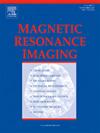Amide proton transfer-weighted MRI distinguishes hepatocellular carcinoma from mass-forming intrahepatic cholangiocarcinoma
IF 2
4区 医学
Q2 RADIOLOGY, NUCLEAR MEDICINE & MEDICAL IMAGING
引用次数: 0
Abstract
Objective
To investigate the potential of amide proton transfer-weighted (APTw) MRI in differentiating hepatocellular carcinoma (HCC) from mass-forming intrahepatic cholangiocarcinoma (MF-ICC).
Methods
76 Patients with histo-pathologically confirmed HCC or MF-ICC underwent dynamic contrast enhanced(DCE) MRI,APTw and DWI. Mean APTw and apparent diffusion coefficient (ADC) of liver tumors were measured independently by two radiologists. Five-point scale were scored with DCE images. Receiver operating characteristic (ROC) curve analysis was used to assess the diagnostic performance of APTw, ADC,DCE in differentiating HCC from MF-ICC.
Results
The HCC group (n = 53) exhibited higher APTw values compared to the MF-ICC group (n = 23)(1.37 ± 0.99 % vs. −0.31 ± 0.79 %, P < 0.001). The ADC values of HCC were lower than those of MF-ICC (0.87 ± 0.14 mm2/s vs. 1.02 ± 0.20 mm2/s, P < 0.001). In differentiating HCC from MF-ICC, APTw demonstrated significantly higher diagnostic accuracy than ADC (AUC: 0.90 vs. 0.72; P < 0.001) and comparable efficacy to DCE-MRI (AUC: 0.90 vs. 0.92; P > 0.05). The optimal APTw threshold for differentiating HCC from MF-ICC was 0.04 %, with a sensitivity of 92 % and a specificity of 78 %.
Conclusion
APTw MRI demonstrated superior discrimination to DWI and comparable diagnostic efficacy to DCE-MRI in differentiating HCC from MF-ICC.
酰胺质子转移加权MRI可区分肝细胞癌和大块形成的肝内胆管癌。
目的:探讨酰胺质子转移加权(APTw) MRI在鉴别肝细胞癌(HCC)与成团型肝内胆管癌(MF-ICC)中的应用价值。方法:76例经组织病理证实的HCC或MF-ICC患者行动态对比增强(DCE) MRI、APTw和DWI检查。肝肿瘤的平均APTw和表观扩散系数(ADC)由两名放射科医师独立测量。用DCE图像进行五分制评分。采用受试者工作特征(ROC)曲线分析评价APTw、ADC、DCE在鉴别HCC与MF-ICC中的诊断价值。结果:肝细胞癌组(n = 53)表现出更高的APTw值相比MF-ICC组(n = 23)(1.37 ± % 0.99 vs -0.31 ±0.79 %,P 2 /秒和1.02 ±0.20 平方毫米/ s, P 0.05)。鉴别HCC与MF-ICC的最佳APTw阈值为0.04 %,敏感性为92 %,特异性为78 %。结论:APTw MRI在鉴别HCC和MF-ICC方面具有优于DWI的鉴别能力,与DCE-MRI具有相当的诊断效果。
本文章由计算机程序翻译,如有差异,请以英文原文为准。
求助全文
约1分钟内获得全文
求助全文
来源期刊

Magnetic resonance imaging
医学-核医学
CiteScore
4.70
自引率
4.00%
发文量
194
审稿时长
83 days
期刊介绍:
Magnetic Resonance Imaging (MRI) is the first international multidisciplinary journal encompassing physical, life, and clinical science investigations as they relate to the development and use of magnetic resonance imaging. MRI is dedicated to both basic research, technological innovation and applications, providing a single forum for communication among radiologists, physicists, chemists, biochemists, biologists, engineers, internists, pathologists, physiologists, computer scientists, and mathematicians.
 求助内容:
求助内容: 应助结果提醒方式:
应助结果提醒方式:


